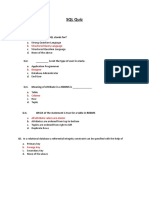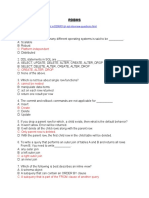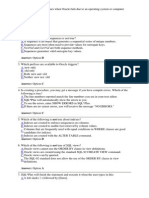Oracle SQL Test
Uploaded by
Gayathri SandhyaOracle SQL Test
Uploaded by
Gayathri SandhyaOracle SQL Test
1. What are features of Primary Key a. Must Be Unique b. Must be Not Null c. A table can have only one Primary Key. d. All the Above. 2. In E-R Model Attributes are represented by a. Rectangle b. Circle c. Oval d. None 3. De- Normalization will result in a. Duplicate Data b. Eliminate Duplicate Data c. Complex Data. d. None 4. A relation is in First Normal Form a. All attributes have repeated Groups b. Have multi value c. Atomic d. None 5. Any change made to the Physical Level should not affect the Logical or User Level a. Information Rule b. View Updation Rule c. Physical Independent Rule d. Logical Independent Rule 6. What is the Process of simplifying Data in to Small tables is known as a. Normalization
b. De Normalization c. Structure d. None 7. Example of Candidate Key a. Foreign Key b. Alternate Key c. Secondary Key d. None
8. In E-R Model Key Constraints are represented as a. Dark Line b. Arrow c. Thin Line d. None 9. In E-R Model Weak Entity is represented by a. Dark Rectangle Box b. Oval c. Line d. None 10.A row is also known as a. Field b. Attribute c. Tuple d. None 11.Merge Statements are discussed under a. DML b. DDL c. TCL d. None 12.TRUNCATE command will keep the Table and remove data permanently a. TRUE
b. FALSE 13.What is the result if the following query executes: SELECT DEPTNO,MAX(SAL) FROM EMP; a. No Error b. Error 14.What is the result if the query executes(SAL=3000,COMM=NULL): SELECT SAL+COMM FROM EMP WHERE EMPNO=7654; a. Error b. 3000 c. NULL d. None 15.What is the default length for CHAR Datatype a. 1 b. 1000 c. No Default Length d. None
16.Examine the query: SELECT * FROM EMP WHERE SAL>2000 AND SAL<3000; Which operator can replace the AND operator a. IN b. BETWEEN c. IS NULL d. NONE 17.What is the output for the following query: SELECT SQRT(POWER(2,2)) FROM DUAL; a. 4 b. 2 c. 0 d. None
18.What is the output for the following Query: SELECT ROUND(8.765,-1) FROM DUAL; a. 10 b. 0 c. 20 d. None 19.What is the output for the following Query: SELECT ROUND(SYSDATE,MONTH) FROM DUAL; Assume sysdate is 12-Aug-2012 a. 01-Aug-2012 b. 01-Jul-2012 c. 30-Aug-2012 d. None 20.The Dictionary view used to get information of UNUSED Columns: a. USER_UNUSED_TABS b. USER_TABS c. USER_UNUSED_COL_TABS d. None 21.The dictionary view used to get information for Comment s on Tables a. USER_COMMENTS b. USER_COMMENT_TABS c. USER_TAB_COMMENTS d. None 22.By Default LTRIM function will remove a. White spaces from the Left b. Removes the String left side c. Removes the string from right side d. None 23.Which function can be used with Numeric and Date values a. SUBSTR b. INSTR c. ROUND d. None 24.What is the output of the function ADD_MONTHS(14-JAN-2012,-1)
a. 14-FEB-2012 b. 14-DEC-2011 c. 14-JAN-2012 d. None 25.What is the output for the query: SELECT ABS(FLOOR(-3/2)) FROM DAUL; a. 2 b. 1 c. 0 d. None 26.SELECT ABS(CEIL(-3/2)) FROM DUAL a. 0 b. 1 c. 2 d. Error 27.The command that will mark JOB as UNUSED a. ALTER TABLE EMP SET UNUSED COLUMN JOB; b. ALTER TABLE EMP SET COLUMN UNUSED JOB; c. ALTER TABLE EMP UNUSED SET COLUMN JOB; d. NONE 28.Which of the following Statement will release a LOCK? a. INSERT b. UPDATE c. COMMIT d. NONE 29.Which Dictionary is a VIEW for USER_CATALOG a. TAB b. CAT c. TABS d. NONE 30.USER_VIEW will give information about Views. a. FALSE b. TRUE 31.The User cannot create Synonym for
a. TABLE b. VIEW c. SEQUENCE d. NONE 32.How can a User modify the SOURCE CODE of View a. CREATE b. REPLACE c. CREATE OR REPLACE d. NONE 33.We cannot perform a DML operation on a View when a. Simple View b. View with WHERE condition c. View with GROUP clause d. None 34.Which of the following is a SET operator a. <> b. = c. LIKE d. UNION ALL 35.Check the following Code: SELECT DEPTNO,JOB,SUM(SAL) FROM EMP GROUP BY DEPTNO,JOB UNION SELECT TO_NUMBER(NULL),JOB,SUM(SAL) FROM EMP GROUP BY JOB; a. Error b. No Error 36.Check the following Code: SELECT SUM(SAL) FROM EMP GROUP BY DEPTNO; a. Error b. No Error 37.How many join condition will exists if we join 100 tables a. 100 b. 200 c. 99 d. 1
38.Display all the matched and unmatched data from both the Tables a. RIGHT OUTER JOIN b. FULL OUTER JOIN c. COMPLETE OUTER JOIN d. LEFT OUTER JOIN 39.To use the NATURAL JOIN a. Table must have common columns b. Table can have un common columns c. Table must have all common columns d. None 40.If 2 tables have more than one common columns in them, and we need to join with one column, we use? a. NATURAL JOIN b. USING Clause c. WITH Clause d. None 41.Which Operator will check multiple values from the INNER QUERY a. In b. = c. > d. None 42.In which Query first executes Inner Query and then Outer Query a. Co-Related Query b. Nested Sub Query c. Scalar Sub Query d. None 43.Which query will return the Second Minimum Salary a. SELECT MIN(SAL) FROM EMP WHERE SAL>(SELECT MIN(SAL) FROM EMP); b. SELECT MIN(SAL) FROMEMP WHERE SAL<(SELECT MIN(SAL) FROM EMP); c. SELECT MIN(SAL) FROM EMP WHERE SAL>=2; d. None
44.Which Sub Query will accepts only one value a. IN b. ANY c. ALL d. = 45.What will the command do? ALTER INDEX IX1 REBUILD; a. Re create Index b. Rebuild Index c. Disable Index d. None 46.The Dictionary view that will get the Status of the Object(VALID OR INVALID) a. USER_OBJECT b. USER_TABLES c. USER_OBJECTS d. NONE 47.Which is Valid Table Name a. EMP!TEST b. EMP TEST c. EMP_TEST d. NONE 48.The Command used to Create a New Table from an existing table without copying data a. CREATE TABLE EMP1 AS SELECT * FROM EMP; b. CREATE TABLE EMP1 AS SELECT * FROM EMP WHERE 1=2; c. CREATE TABLE EMP1 AS SELECT * FROM EMP WHERE JOB=CLERK d. NONE 49.TAB is a a. View b. Synonym c. Table d. None 50.All SAVEPOINTS will be cancelled after issuing COMMIT
a. TRUE b. FALSE
You might also like
- Víctor Olaya - ''A Gentle Introduction To SAGA GIS (Edition 1.1) ''No ratings yetVíctor Olaya - ''A Gentle Introduction To SAGA GIS (Edition 1.1) ''217 pages
- 345 - SQL Database Fundamentals - R - 2018100% (1)345 - SQL Database Fundamentals - R - 201810 pages
- Ans: Cursor Has Not Been Declared With Hold OptionNo ratings yetAns: Cursor Has Not Been Declared With Hold Option12 pages
- DP s16 l04 FinalExamReviewSections10 To 13answersNo ratings yetDP s16 l04 FinalExamReviewSections10 To 13answers7 pages
- Oracle, SQL & PL/SQL: What Is The Full Form of SQL?No ratings yetOracle, SQL & PL/SQL: What Is The Full Form of SQL?17 pages
- Oracle Mockup Exam CHN09JM001 - Pattern 1No ratings yetOracle Mockup Exam CHN09JM001 - Pattern 16 pages
- Level 3 COC Database Students Institutional AssessmentNo ratings yetLevel 3 COC Database Students Institutional Assessment16 pages
- Oracle Java Foundation: Review Modul 6 - 9100% (1)Oracle Java Foundation: Review Modul 6 - 943 pages
- A. CALL Proc1 ( SALES', ?) : Create Procedure Proc1 (In Var1 Varchar (10), Out RC Integer) Specific Myproc Language SQLNo ratings yetA. CALL Proc1 ( SALES', ?) : Create Procedure Proc1 (In Var1 Varchar (10), Out RC Integer) Specific Myproc Language SQL3 pages
- CC6001ES ADSD SQL Exam Model Paper 1 AnswersNo ratings yetCC6001ES ADSD SQL Exam Model Paper 1 Answers12 pages
- Exam: NR0-013 Title: Teradata SQL v2r5 Ver: 03-03-08100% (1)Exam: NR0-013 Title: Teradata SQL v2r5 Ver: 03-03-0837 pages
- CCE 122 Java Interview Question (Marked)No ratings yetCCE 122 Java Interview Question (Marked)54 pages
- Cassandra Query Language by Examples - Puzzles with AnswersFrom EverandCassandra Query Language by Examples - Puzzles with AnswersNo ratings yet
- Simon Kasdin - The Esoteric Tarot - The Key To The Cabala-The Emerson Society (1965) OPTNo ratings yetSimon Kasdin - The Esoteric Tarot - The Key To The Cabala-The Emerson Society (1965) OPT92 pages
- Harshit's WLP On Dabur India Ltd. HarshitNo ratings yetHarshit's WLP On Dabur India Ltd. Harshit46 pages
- Preident Uhuru Kenyatta's Speech During The 2013 a.S.K. Nairobi International Trade Fair, Jamhuri Park Showground, NairobiNo ratings yetPreident Uhuru Kenyatta's Speech During The 2013 a.S.K. Nairobi International Trade Fair, Jamhuri Park Showground, Nairobi4 pages
- Conducting Cambridge IGCSE ICT (0417) Practical Tests June 2019No ratings yetConducting Cambridge IGCSE ICT (0417) Practical Tests June 20196 pages
- Mec 291: Dynamics and Materials LAB Mechanism and Machine ElementsNo ratings yetMec 291: Dynamics and Materials LAB Mechanism and Machine Elements22 pages
- EX5218-Report-Vol1-Sec1-Certificate of Compliance-20150528 - 55L - 55L-60No ratings yetEX5218-Report-Vol1-Sec1-Certificate of Compliance-20150528 - 55L - 55L-601 page
- Proses Pengawetan Daging Pasca Panen Melalui PengasapanNo ratings yetProses Pengawetan Daging Pasca Panen Melalui Pengasapan4 pages
- Víctor Olaya - ''A Gentle Introduction To SAGA GIS (Edition 1.1) ''Víctor Olaya - ''A Gentle Introduction To SAGA GIS (Edition 1.1) ''
- Ans: Cursor Has Not Been Declared With Hold OptionAns: Cursor Has Not Been Declared With Hold Option
- Oracle, SQL & PL/SQL: What Is The Full Form of SQL?Oracle, SQL & PL/SQL: What Is The Full Form of SQL?
- Level 3 COC Database Students Institutional AssessmentLevel 3 COC Database Students Institutional Assessment
- A. CALL Proc1 ( SALES', ?) : Create Procedure Proc1 (In Var1 Varchar (10), Out RC Integer) Specific Myproc Language SQLA. CALL Proc1 ( SALES', ?) : Create Procedure Proc1 (In Var1 Varchar (10), Out RC Integer) Specific Myproc Language SQL
- Exam: NR0-013 Title: Teradata SQL v2r5 Ver: 03-03-08Exam: NR0-013 Title: Teradata SQL v2r5 Ver: 03-03-08
- Redis Certified Developer - Exam Practice TestsFrom EverandRedis Certified Developer - Exam Practice Tests
- Cassandra Query Language by Examples - Puzzles with AnswersFrom EverandCassandra Query Language by Examples - Puzzles with Answers
- Oracle Certified Associate Java Programmer OCAJP 1Z0 808From EverandOracle Certified Associate Java Programmer OCAJP 1Z0 808
- Couchbase Certified Java Developer - Exam Practice TestsFrom EverandCouchbase Certified Java Developer - Exam Practice Tests
- Simon Kasdin - The Esoteric Tarot - The Key To The Cabala-The Emerson Society (1965) OPTSimon Kasdin - The Esoteric Tarot - The Key To The Cabala-The Emerson Society (1965) OPT
- Preident Uhuru Kenyatta's Speech During The 2013 a.S.K. Nairobi International Trade Fair, Jamhuri Park Showground, NairobiPreident Uhuru Kenyatta's Speech During The 2013 a.S.K. Nairobi International Trade Fair, Jamhuri Park Showground, Nairobi
- Conducting Cambridge IGCSE ICT (0417) Practical Tests June 2019Conducting Cambridge IGCSE ICT (0417) Practical Tests June 2019
- Mec 291: Dynamics and Materials LAB Mechanism and Machine ElementsMec 291: Dynamics and Materials LAB Mechanism and Machine Elements
- EX5218-Report-Vol1-Sec1-Certificate of Compliance-20150528 - 55L - 55L-60EX5218-Report-Vol1-Sec1-Certificate of Compliance-20150528 - 55L - 55L-60
- Proses Pengawetan Daging Pasca Panen Melalui PengasapanProses Pengawetan Daging Pasca Panen Melalui Pengasapan

























































































